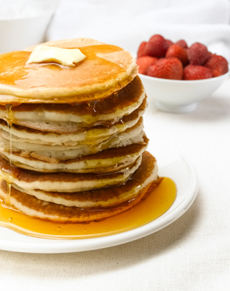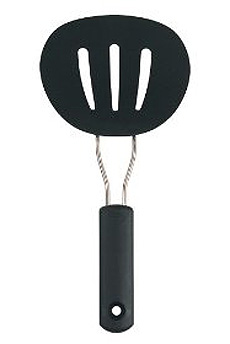

The biggest challenge to making good pancakes is getting the batter right. Photo by Stuart Burford | IST.
STEPHANIE ZONIS focuses on good foods and the people who produce them.
|
November 2009
|
 |
Best Pancake Mixes: Whole Grain & Multigrain
Page 5: Griddle Me This...& Watch Out For That Pancake Batter
This is Page 5 of a 6-page article, plus 18 pages of product reviews. Click the black links below to visit other pages.
General Findings
Pancake Batter Consistency
Batter consistency was the single biggest issue I ran across in these mixes. When mixed according to package directions, not enough mixes had a consistency good for making pancakes.
- Too-thin batter. Most were too thin; many were only slightly thicker than water. There were two ways to remedy this. Sometimes, adding more dry mix was a solution, but I had to be extremely careful not to overmix the batter, or I’d end up with tough pancakes (that happened once or twice). Plus, adding more mix wasn’t always a possibility, as some mixes require use of the entire envelope or package of mix to make a batch of pancakes.
- Alternatively, I could also let the batter stand at room temperature. Many too-thin batters would thicken by themselves if they stood for 15 to 30 minutes. In fact, a number of the mixes instructed you to prepare the batter, then let it stand for up to 20 minutes before baking your pancakes.
- Too-thick batter. The batters that were too thick, by contrast, could be thinned by adding more liquid, but you had to add liquid gradually so you wouldn’t get the batter too thin, and, again, trying not to overmix the batter was a challenge.
A few mixes suggested a range of liquid, which seemed to me to be the smart thing to do. A range measurement would allow for all kinds of different conditions, including the maker’s preferences. Instructions such as “for thinner pancakes, add more liquid; for thicker pancakes, use less” won’t cut it if you’re a novice cook, because you’re probably uncertain how thick a pancake batter should be, or how to remedy batter consistency. That’s one of the reasons you’re using a mix in the first place.
Note To Manufacturers: Make It Easy
Mixes, including pancake mixes, are a convenience food. That being the case, shouldn’t these mixes be, oh, I don’t know...convenient? You’re paying more for ease of preparation. Is there anyone out there who would be happy to make up a pancake batter and then have to let it stand for 20 minutes so it can reach an optimal consistency?
On the other side of the coin, I ran across a few batters that thickened drastically to the consistency of wet concrete in the amount of time it took me to preheat my griddle. This shouldn’t be happening, either. I understand that conditions and ways of measuring are going to differ from place to place and person to person, but it isn’t too much to ask that a mix make up into a batter of appropriate consistency. I know this because there were some mixes that got it right.
The Easiest Solution
If you live in a small household, only eat pancakes occasionally and aren’t otherwise preoccupied with food the way I am, it’s likely that the most convenient type of mix for you will be a so-called “complete” or JAW (“just add water”) mix.
- With a JAW, you are not required to use an entire package or envelope of mix to make pancakes. You simply measure out the amount of mix you think you’ll need and add water, a bonus if you don’t always keep milk, eggs, butter or oil in the house.
- Having said that, many pancake batters will keep overnight in the fridge, if tightly covered (likely exceptions would be those with beaten egg whites folded into the batter, as the whites will deflate over time).
- Some sources indicate that batter refrigerated longer than about 12 hours may produce tough pancakes with low volume, but I didn’t find this to be true (I did overnight spot-checks of some batters by storing them, tightly covered, in my refrigerator and baking them the next day).
- Additionally, while I haven’t tried this, I have read several times and in different places that you can freeze home-cooked pancakes and microwave them. My colleagues at THE NIBBLE, however, made and then froze several of my top pick pancake recommendations. They report that the pancakes tasted just as good out of the microwave, even after they had been frozen days, and even weeks, after they were first made.
Get A Nonstick Griddle
If you think you might be whipping up any significant quantity of pancakes in the future, I urge you to acquire:
- A nonstick griddle
- A nonstick, broad-bladed metal
pancake turner
- A whisk or two.
I ran across some batters and finished pancakes with peculiar consistencies during my tests, but almost nothing stuck to my beloved nonstick griddle, nor to my nonstick pancake turner. And nothing beats a whisk for combining batter ingredients. |
|

This nylon flexible pancake turner from OXO’s Good Grips collection won’t scratch nonstick cookware. |
Continue To Page 6: Pancake Mix Product Reviews
Go To The Article Index Above
Lifestyle Direct Direct, Inc. All rights reserved. Images are the copyright of their respective owners.

|





